British Food: 29 Best UK Dishes (& Where to Try Them)
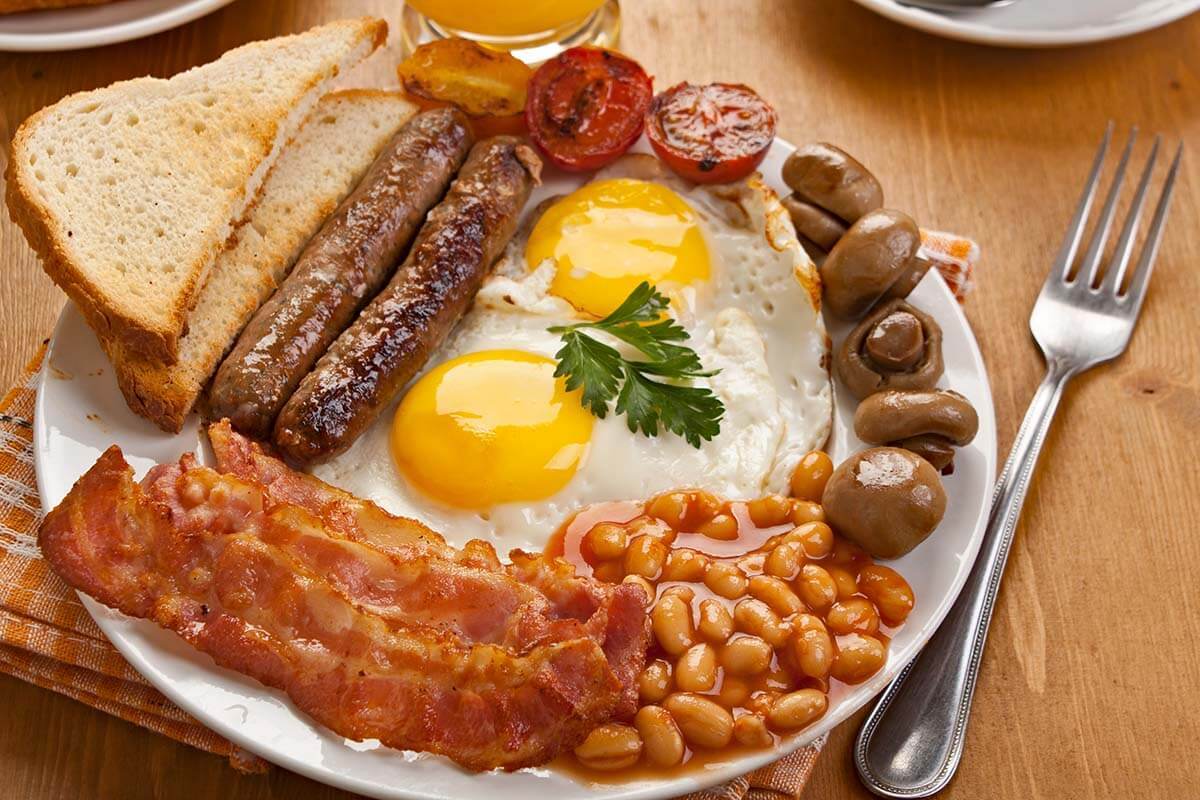
Planning a trip to the UK and looking for some typical British foods to try during your visit? In this guide, we feature a selection of the best British food – the very best traditional dishes and desserts in the UK. For each dish, we also give you local’s tips for how they are typically served and where to try them.
Good to know: This guide is written by our writer Christine from Blackpool, UK. Born and raised in Great Britain, she proudly shares the best of British cuisine with our readers. Her selection of the best British food includes traditional dishes from all over the United Kingdom. So not only the typical English or Scottish food that is widely known, but also some regional specialties that you can only find in the UK.
When it comes to traditional British food, many visitors don’t think further than fish and chips! But when you consider that the United Kingdom is made up of four different countries (England, Scotland, Wales, and Northern Ireland) – each with its own distinct culture and history – then it stands to reason that there will be a lot of culinary diversity!
From regional specialties originating on the coast of Wales to decadent desserts that you’ll find all over the UK, discover more about the unique national dishes of Great Britain. Take a look!
Good to know: Our list of the best traditional British food starts with the most famous main dishes. The best British desserts are listed further below, at the end of the article.
And yes, you will get hungry when reading this… Take a look!
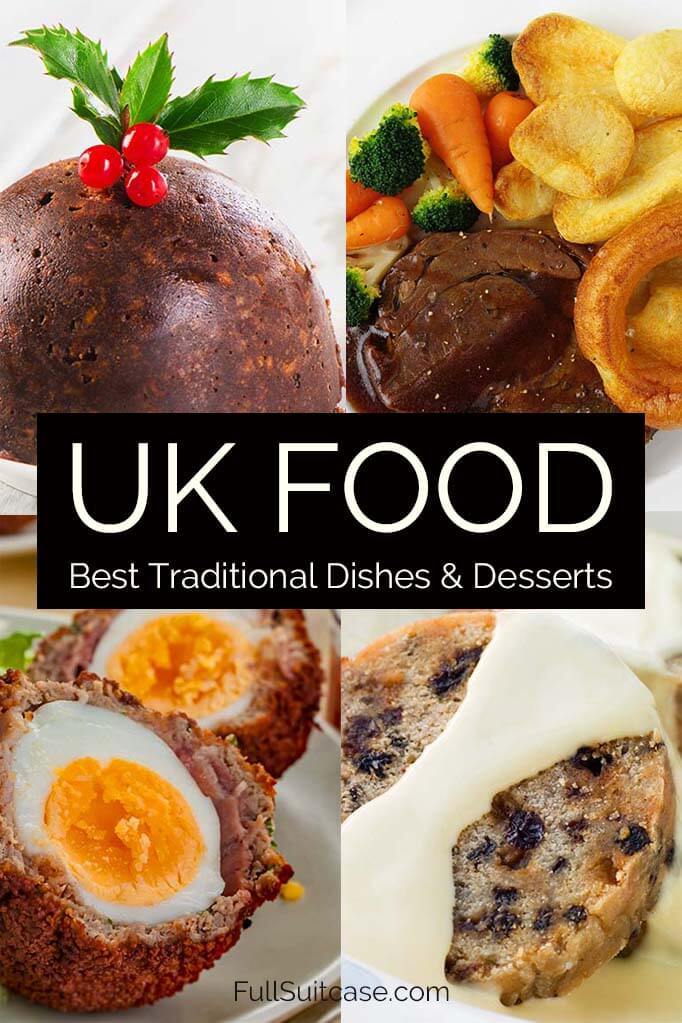
Here is the best British food to try in the UK:
1. Fish and Chips
Considered to be the national dish of the UK – and still the most popular takeaway in all four of its nations – fish and chips is something of a British institution! So it would be unthinkable to start the list of the best British food with anything other than our world-famous fish & chips…
The perfect comfort dish on a cold day, a typical fish and chip dinner will consist of a large piece of white fish (usually cod or haddock) coated in batter and deep-fried to crispy perfection. Traditionally, in the UK, the fish is served with chunky chips, never with fries.
This is typically smothered liberally with salt and vinegar, then wrapped in paper and served to take away. Wrapping the meal has the effect of slightly steaming the chips, giving them a softness that Brits love! Traditionally, the paper would have actually been a newspaper, but you don’t see this often anymore. In honor of this tradition, some places have special wrapping paper that looks like a newspaper.
Side dishes to complete the meal of fish and chips include unique delicacies such as pickled eggs, pickled onions, or – most popular of all – mushy peas (which are precisely as they sound).
Origin: Both Lancashire and London claim to have invented fish and chips, although the exact origin is unclear. However, Charles Dickens referred to a ‘fried fish warehouse’ in Oliver Twist. And London did, indeed, have the first fish and chips shop, which opened in 1860.
Where to try it: You will find fish and chips served everywhere in the UK, from street-food stalls to upscale restaurants. But for a true, authentic experience, buy them from a proper fish and chip shop (locally known as a ‘chippy’) and eat them directly from their paper wrapping.
TIP: If you are visiting London and want to try some typical British food (including some of the best fish & chips in town), we highly recommend this amazing traditional food tour!
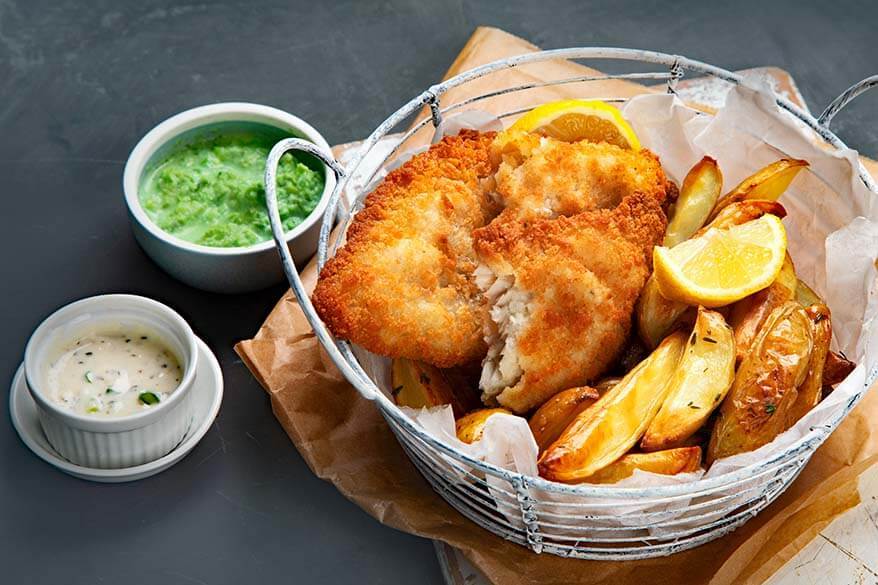
2. Shepherd’s Pie
When is a pie not really a pie? Perhaps when it’s Shepherd’s Pie, one of the UK’s favorite dishes, that doesn’t really meet the criteria to be called a pie at all. A close relative to Shepherd’s Pie is Cottage Pie (also not really a pie). It is made with minced beef instead of lamb.
Shepherd’s Pie is a hearty meal containing a bottom layer of meat – usually minced or diced lamb – cooked with onions and other vegetables in a rich gravy. It’s then topped with a thick layer of mashed potato and baked.
Origin: All four nations of Britain lay claim to having invented Shepherd’s Pie, but its true origins are not quite clear. The legend has it that the dish was originally created in Scotland, where it was topped with pastry (and therefore more closely resembled a true pie).
Apparently, the recipe then made its way over to Ireland, where potatoes were a favorite and staple food. The Irish decided to do away with the pastry topping and use a layer of mashed potato instead. This revision to the recipe has stuck ever since.
Where to try it: You will find Shepherd’s Pie served in almost every restaurant and pub in the UK, sometimes given a healthy spin such as a sweet potato topping.
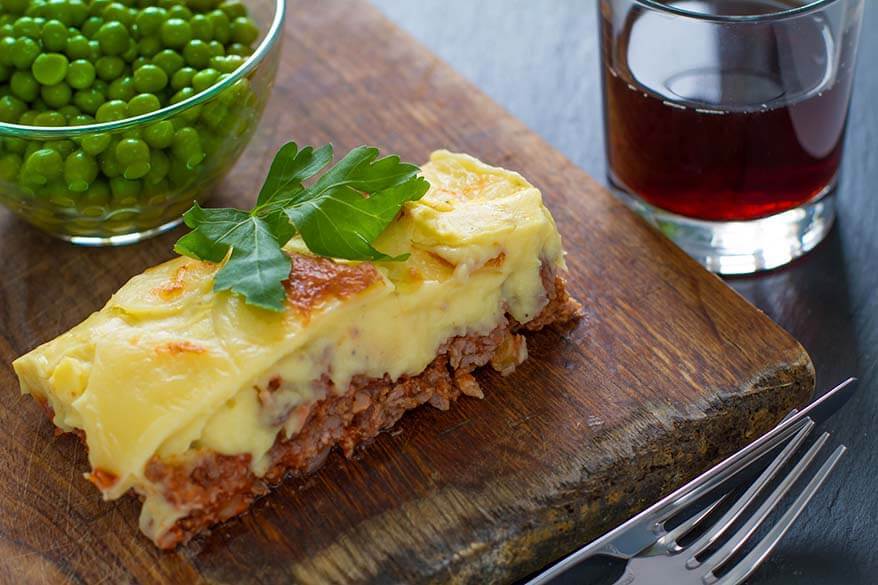
3. Steak and Kidney Pie / Pudding
Steak and Kidney Pie (or Steak and Kidney Pudding) is one of those typical British dishes that you just have to try!
The filling is composed of diced steak combined with chopped onion and kidney, usually from a pig or lamb. This mixture is cooked with brown gravy, then encased in pastry and baked. Or – in the case of steak and kidney pudding – steamed for several hours in a suet pastry. Occasionally mushrooms are added, along with some type of ale.
The kidneys lend a full, gamey flavor to the filling. It certainly tastes unique but is quite delicious. It’s usually accompanied by mashed potatoes, green beans, and lots of gravy.
Where to try it: Steak and kidney pie is widely served throughout the UK and is a classic pub favorite.
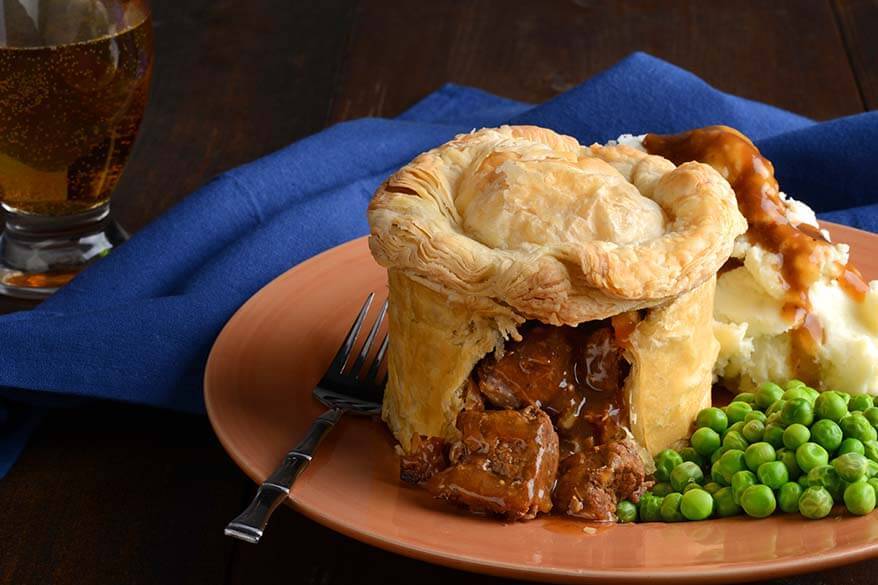
4. Haggis, Neeps & Tatties
Haggis is the national dish of Scotland and is traditionally served with mashed root vegetables – neeps (turnips) and tatties (potatoes). With a texture of a highly seasoned, crumbly sausage, haggis was traditionally made of a mixture of sheep offal (heart, liver, and lungs), minced with oats, onion, suet, salt and spices, then boiled in a sheep’s stomach.
The ingredients have changed somewhat over the years. These days, synthetic casings tend to be used instead of the sheep’s stomach. In addition, sometimes the offal will be from cows or even deer instead of sheep.
Nevertheless, this typical Scottish dish remains a firm favorite and you will find it served across Scotland. However, it’s truly a regional specialty and so you’ll rarely find haggis anywhere else in the UK.
Interesting to know: Haggis plays a big part in Burn’s night celebrations on January 25th, which commemorate Scottish poet Robert Burns. He raised the profile of the Scottish national dish across the world with his poem ‘Address to a Haggis’.
Where to try it: You can enjoy a good haggis meal in almost any Scottish pub. But for the best experience head to Edinburgh and dine at the White Hart Inn, the capital city’s oldest pub. Another great way to get to know more about traditional Scottish food and taste some of it is by joining a local food tour in Edinburgh!
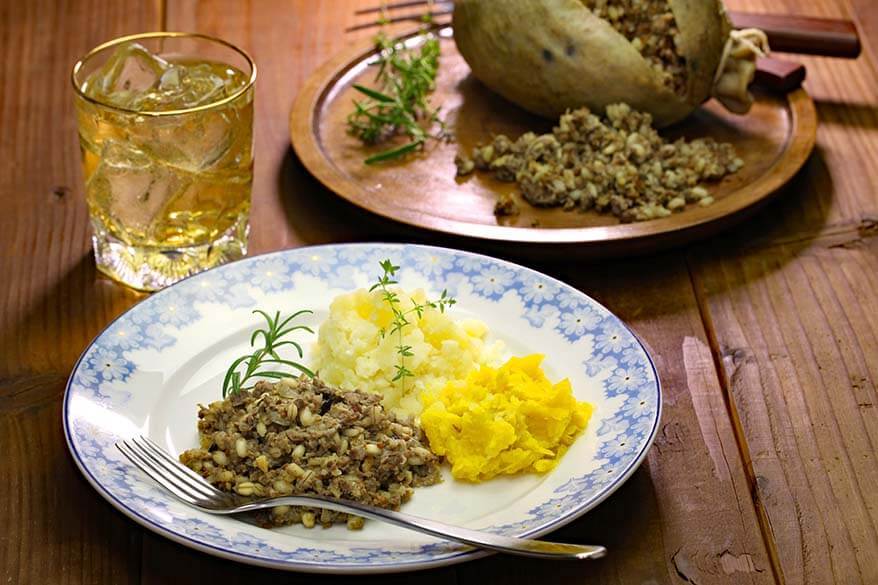
5. Bangers and Mash
Another staple part of the British pub menu is Bangers and Mash. It is a hearty meal and comes covered in a rich onion gravy, with vegetables on the side. Traditionally a dish for the working classes, you can find gourmet versions made with specialty sausages and a mash made with other root vegetables like carrot or swede.
While the ‘mash’ part of the dish simply refers to mashed potatoes, the term ‘bangers’ might be a bit more elusive.
A banger is actually a British sausage. It doesn’t refer to any regional specialty but is a blanket term applied to all sausages produced in the UK. But why are they called bangers?
This term was supposedly coined during the First World War when the combination of the cheap ingredients used to fill the sausages and their tight skins caused them to explode in the pan! Strangely, though, no one calls sausages bangers at any other time – they are only bangers when served with mashed potato in this traditional British dish!
Where to try it: You can find Bangers & Mash in pubs and restaurants all over UK.
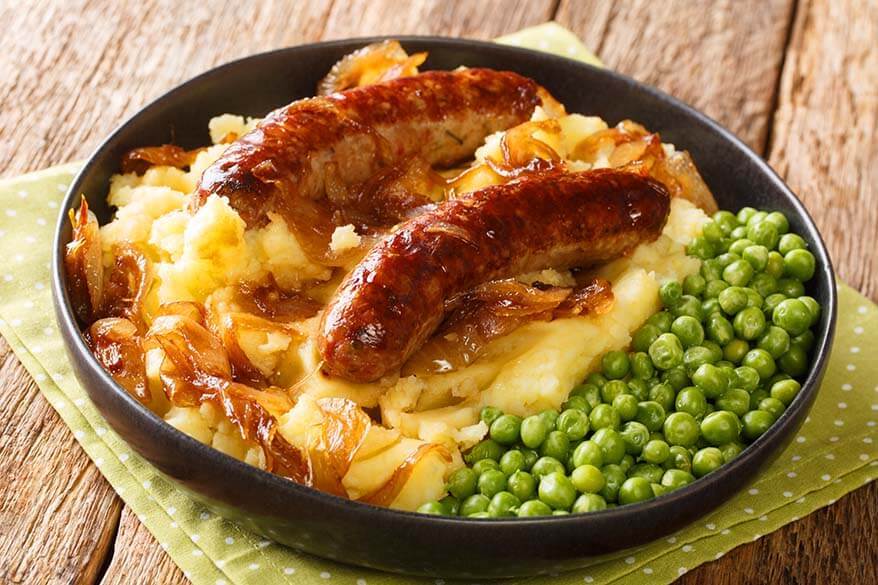
6. Yorkshire Pudding
Yorkshire Pudding is one of those traditional British foods that is not what foreigners expect it to be. It has nothing to do with sweet custard that the rest of the world calls ‘pudding’. Yorkshire pudding is a sort of savory pastry, made from a batter of eggs, flour, and water or milk. It’s usually served as a side dish.
These days, Yorkshire puddings are served alongside a Sunday roast (see further below), but that’s not how they started. Originally they were given as an appetizer, covered with gravy, in order to take the edge off the appetite of the diner whose main meal was too small to be satisfying!
When Yorkshire puddings were first served on the Sunday roast it would be to accompany the beef. These days, they tend to be included no matter what meat is cooked.
And whilst the batter is now divided into individual little puddings, originally it was cooked in one large tin and cut into squares.
Origin: You might be forgiven for thinking that Yorkshire puddings originated in Yorkshire, but this isn’t necessarily the case. Instead, they got their name from a 1747 cookery publication that called them ‘Yorkshire’ puddings to describe the light and airy batter made in that region, compared to the batter made in the rest of England.
Where to try it: Yorkshire puddings are served right across the UK. They are usually available wherever you find a Sunday roast, with the best (and biggest) to be found in traditional British pubs.
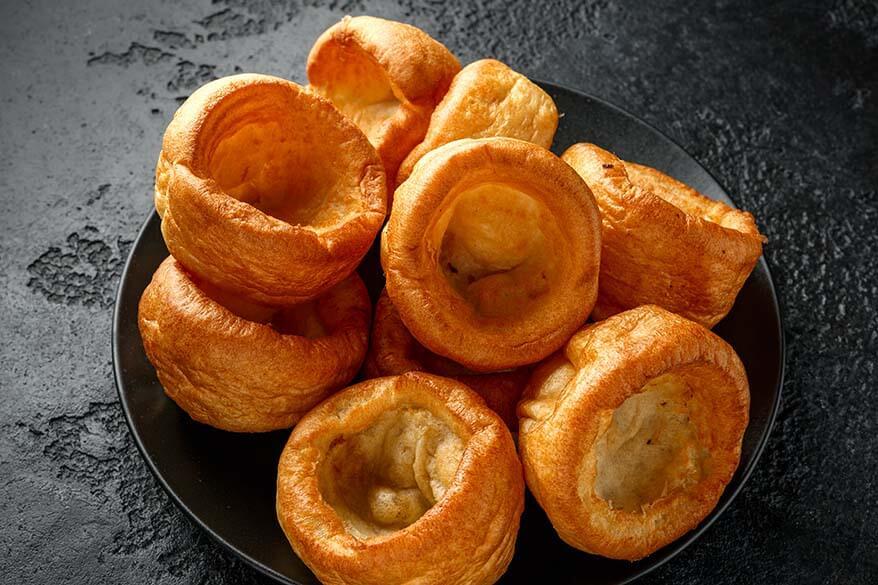
7. Sunday Roast
The Sunday Roast is a long-standing British institution and, to this day, one of the UK’s favorite meals. It is sometimes referred to as the ‘Sunday joint’ in reference to the roasted joint of meat that lies at the heart of the meal. In addition to the meat, it also contains roasted potatoes, stuffing, vegetables (typically cauliflower cheese, peas, and Brussels sprouts), and Yorkshire puddings.
This feast of a meal is then smothered in a rich gravy made from the juices of the meat, along with a sauce to accompany the specific meat used. Horseradish sauce accompanies beef, mustard goes for pork, mint sauce with lamb, and cranberry sauce with chicken.
The Sunday roast is a big part of family life in the United Kingdom and it is believed that its origins lie at the time of the Industrial Revolution. Families getting ready for the church would put a joint of meat in the oven to start cooking and would then add potatoes and vegetables as they left. On their return from church, the meal would be virtually ready.
Where to try it: You can enjoy a traditional roast dinner in most UK restaurants on Sundays. But for the very best experience head to a traditional British pub on a Sunday afternoon!

8. Full English Breakfast
There’s no better way to start your day in the UK than with a full English breakfast. The use of the word ‘full’ here is more than appropriate. This is a feast of a meal that will quite possibly keep you going right up until dinner time!
A ‘full English’ is also known as a fry-up because of the method used to cook the ingredients. It usually consists of bacon slices (called rashers), sausages, eggs (fried, poached, or scrambled), mushrooms, baked beans, fried or grilled tomatoes, black pudding, and fried bread. As if all of this isn’t enough to fill you up, it also comes with a side serving of hot buttered toast and a cup of British tea!
There are a few regional variations on the full English, with each nation of the UK adding its own twist. The ‘full Scottish’ will usually contain Tattie Scones (potato scones) and the square ‘Lorne sausage’. A ‘full Welsh’ may include laverbread along with locally sourced ingredients. A ‘full Irish’ is much more likely to contain white pudding than black (white pudding contains no blood, just pork, spices, and oatmeal).
Where to try it: A full English breakfast is served at just about every UK eatery. And the good news is that you’re not just limited to eating it in the mornings! Most British pubs offer an ‘all-day breakfast’ option so you can tuck into this wonderfully hearty meal whenever the fancy takes you!
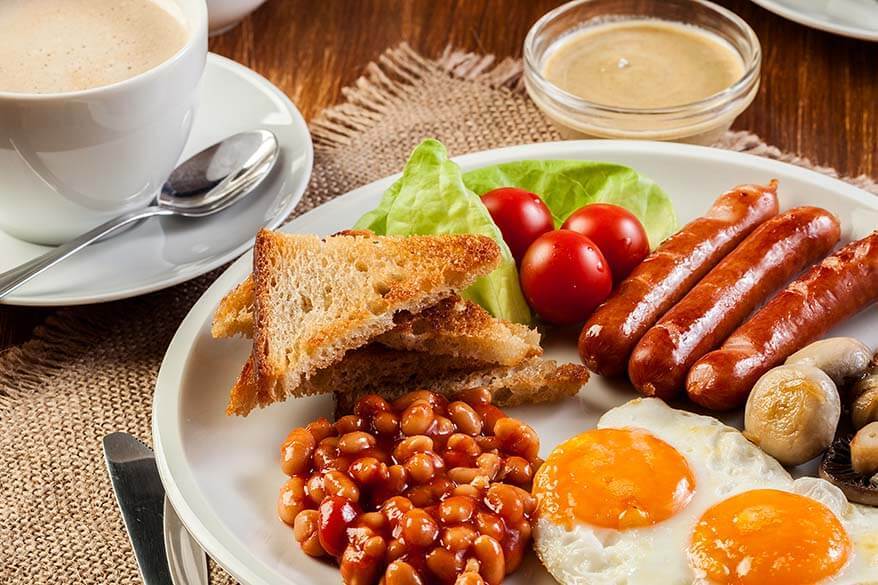
9. Black Pudding
Black pudding is a kind of sausage and deserves a separate mention among the most typical dishes in the UK. It’s a central part of the full English breakfast, particularly in the north of England where it is most popular.
Unlike other sausages, however, this one is made with blood combined with a filler like oatmeal, and cooked long enough for it to congeal. It is one of those dishes that some people like and others refuse to try. But it is actually quite a healthy alternative to regular sausages and tastes a lot better than it sounds!
Black pudding is actually an ancient food and there are references to it in Roman cooking literature as early as the 4th or 5th century AD. It has had a chequered history and has even been banned in the past. In some religious circles, eating this ‘blood sausage’ was considered to be very controversial.
Where to try it: You will find black pudding all over the UK. However, if you want to try it, I would recommend ordering the restaurant-quality version. Many cafes and hotel breakfasts serve lower quality black pudding that doesn’t give you a true idea of how tasty this dish can be!

10. Cullen Skink
Its name may sound unappealing but Cullen Skink is a very delicious Scottish fish soup. It’s made from a mixture of smoked haddock, potatoes, and onions, along with milk or cream.
The dish originated in the fishing town of Cullen in Morayshire on Scotland’s northeast coast. There, it was made with Finnan haddie – a regional, cold-smoked haddock. Now enjoyed all over Scotland, it is typically made with any type of undyed haddock.
The origins of the ‘skink’ part of its name are a little unclear. Some say it comes from a Gaelic word for ‘essence’ and others say that the word refers to the scraps of beef that were originally used to make soup.
Where to try it: Cullen Skink is warm, hearty and the perfect food to enjoy in Scotland’s chilly climate, where you will find it served in almost every restaurant and bar. It is less common outside Scotland, but you will still sometimes see it on menus in other parts of the United Kingdom. If you do, I strongly recommend giving it a try!

11. Toad in the Hole
Many of Britain’s favorite dishes fall into the category of ‘comfort food’ – probably thanks to the country’s damp and chilly climate. Toad in the Hole is no exception!
Thankfully this oddly-named dish doesn’t actually contain any toads. It’s a batter pudding containing meat, originally steak, offal, or pigeon. The batter is the same recipe as that used for Yorkshire puddings (see above). However, with Toad in the Hole, the meat is baked inside the batter, which then rises and envelops it.
This is probably how the dish got its name, as the meat somewhat resembles toads peeking out from their holes.
Toad in the Hole was created by poorer families who needed to find a way to make their meager meat supplies go further. Combining them with a hearty but inexpensive batter was a great way to make a filling meal out of very little.
These days, Toad in the Hole is made with pork sausages and is still considered a very simple and rustic dish. Although modern chefs like to put their own tasty twist on it by adding ingredients like fresh rosemary and gourmet sausages.
Where to try it: Toad in the Hole is mainly served in UK pubs. But make sure you’re hungry before ordering as portions tend to be huge and are accompanied by lots of gravy, mashed potatoes, and vegetables.

12. Pie, Mash & Liquor
Move over fish and chips – London has another traditional food that may just be the capital’s favorite! Pie, mash, and liquor sauce has been on the menu of Londoners since the early 1800s when the first ‘Eel Pie and Mash’ houses opened.
London’s River Thames had a big influence on its culinary scene at the time. And although it was heavily polluted, eels thrived in its waters. Workers would put the eels into a pie, which was then served with mashed potato. The water used to cook the eels formed the basis of the ‘liquor sauce’, which – despite its name – contains no alcohol.
Modern-day pie & mash is – perhaps thankfully – no longer made with eels, and minced beef is often used instead. Neither does the liquor sauce contain an eel broth. It does have quite an alarming green color which many visitors worry is connected to eels, but it is actually produced by its main ingredient – fresh parsley.
Where to try it: It is very hard to find traditional pie, mash, and liquor outside of London. But in the capital, this once-neglected traditional meal has seen a big revival in recent years. There are now lots of pie & mash restaurants throughout London.
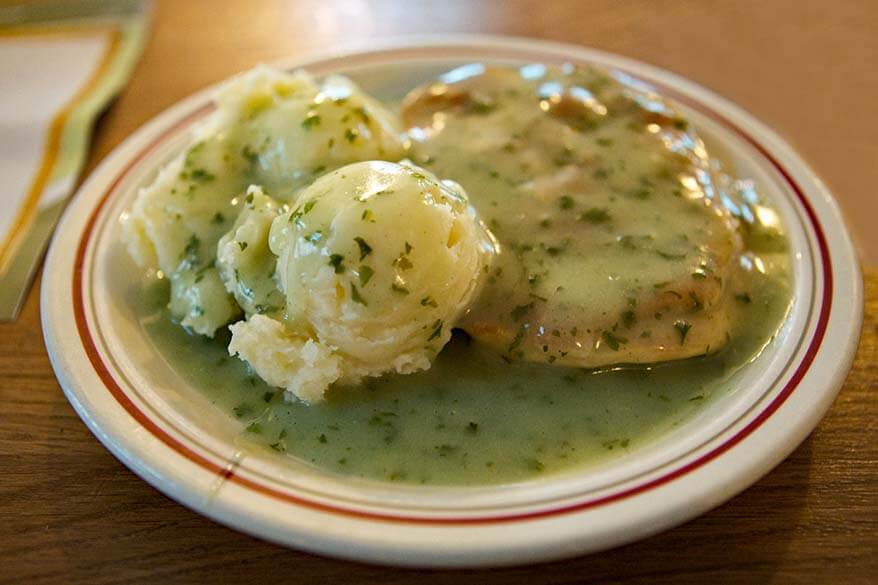
13. Cornish Pasty
The Cornish pasty from Cornwall in the southwest of England has its roots way back in the 13th century when it was enjoyed by royalty and the nobility. In the 17th century, Cornish farmers and mineworkers adapted the recipe somewhat in order to create a simple, nourishing meal that they could eat as they worked.
The more humble variety of the dish is now enjoyed all across the UK. Pasty consists of a filling (traditionally beef, potato, onion, and swede) sealed and cooked together in a pastry ‘packet’, which is crimped together into a thick crust at one edge.
This made it easy for workers to hold their meal in their hands as they toiled. It was particularly favored by miners, whose very dirty hands may have contaminated any other meal.
Where to try it: Pasties are widely available in bakeries across the UK and they are served hot for lunch. But to be labeled a true ‘Cornish’ pasty it has to meet specific criteria: it should contain no meat other than beef (at least 12.5%), and no vegetables besides potato, onion, and swede.
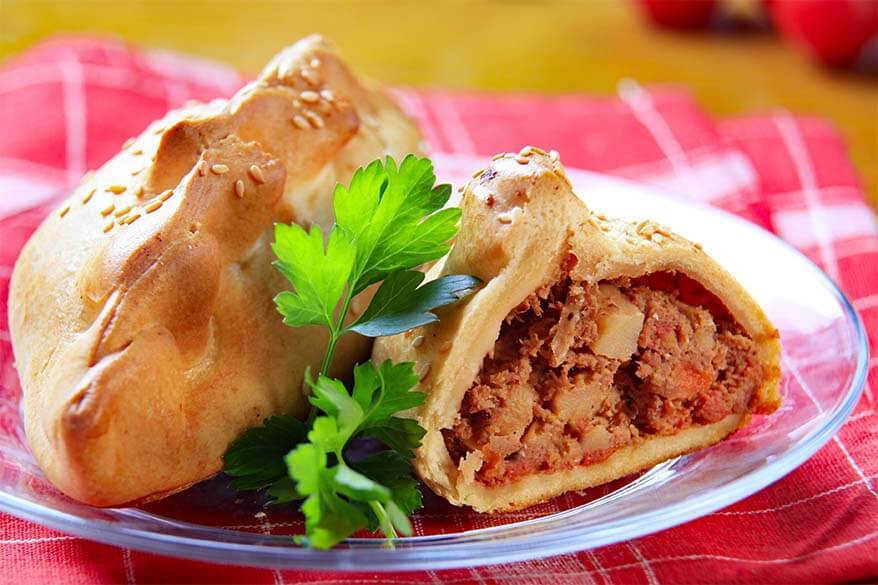
14. Irish Stew
Probably Ireland’s best-loved dish, Irish Stew has its origins in the early 1800s. It was a meal enjoyed by the very poorest of the working classes.
There are two major components of the dish – meat and potatoes. Originally the meat would have been mutton, which was widely available at that time. Indeed, the peasants – who relied on their sheep for milk and wool – kept them well into their old age, by which time the meat had to be stewed to be edible!
Potatoes first arrived in Ireland in the 16th century and went on to play a very significant part in the diet of the working classes. To this day, Irish dishes tend to revolve around a central ingredient of potatoes. Irish Stew is no exception, with purists saying that nothing more than meat and onions should be added.
These days, though, the stew tends to contain additional root vegetables like carrots, parsnips, and turnips and the meat used is usually beef or lamb instead of mutton. Another modern (and very welcome) variation is the addition of Guinness stout, which really helps increase the flavor of the dish.
Where to try it: You will find Irish Stew on pub and restaurant menus throughout Ireland and Northern Ireland. Although many people agree that the best Irish Stew is served in the pubs of Dublin and Belfast, it’s a popular dish that you’ll find in some other parts of the United Kingdom too.
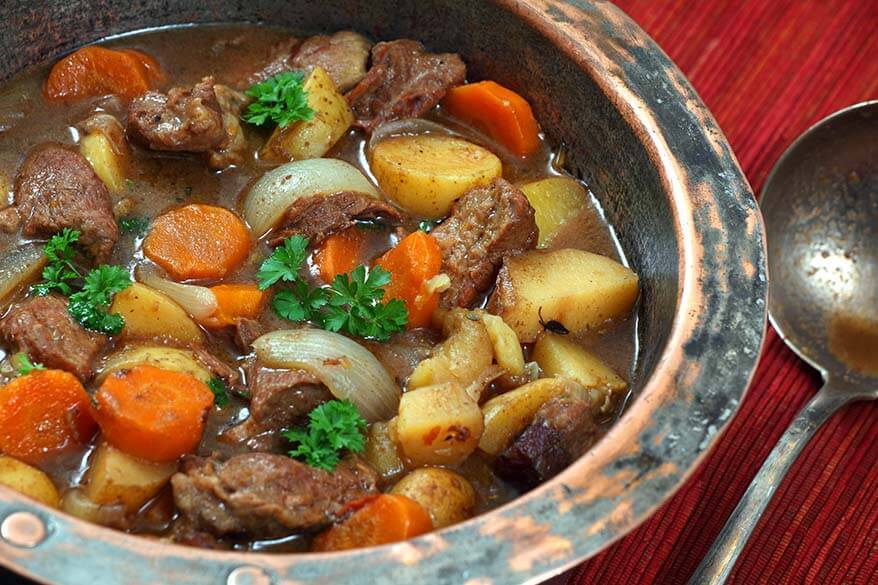
15. Lancashire Hot Pot
Lancashire Hot Pot dates back to the 19th century and it originated in Lancashire, north-west England. The cotton industry was booming at that time and many housewives went to work in the cotton mills. So they needed to prepare an evening meal that they could leave to simmer for hours whilst they were away.
They would combine meat and vegetables in a steep-sided dish and cover it with a layer of sliced potatoes, then leave it to slowly cook throughout the day. The bones in the meat would provide flavor and produce a rich gravy, creating a popular dish that became commonly known as Lancashire Hotpot.
Today, hotpot is usually prepared with lamb. But originally lamb would have been too expensive for the working families and mutton would have been used instead. Other than that, the Lancashire Hotpot hasn’t changed too much.
Where to try it: You can find this warming and nourishing dish served right across the UK, although most commonly in Lancashire pubs. It is best washed down with a pint of local ale.

16. Bubble and Squeak
Bubble and Squeak is named after the ‘bubbling’ and ‘squeaking’ noises of its ingredients cooking together. It is made from chopped vegetables (usually, cabbage) combined with mashed potato, then formed into patties and fried in lard or butter until golden.
The dish has been referenced since the 1700s and the first proper recipe appeared in 1806. Although, in the past, beef was used instead of mashed potato. By the end of the 19th century, the meat started to disappear from the recipe and seemed to have been dropped altogether around the time of WW2, probably because it was rationed and hard to get hold of.
The dish went on to become a favorite of British housewives who would cook it to use up the leftovers from the traditional Sunday Roast. This is why Bubble and Squeak is most commonly eaten in British homes on a Monday, either as part of a fried breakfast or for lunch.
Where to try it: If you want to try Bubble and Squeak for yourself, you are most likely to find this classic British favorite on the menus of restaurants providing a full English breakfast.
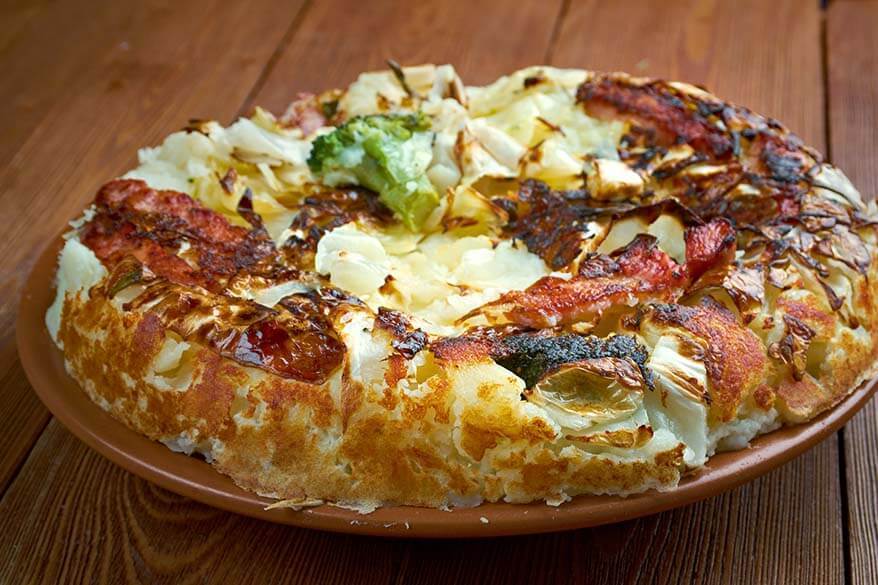
17. Scotch Egg
The Scotch egg is a rather strange creation, much loved right across the UK. It consists of a hard-boiled egg, wrapped in sausagemeat, covered in breadcrumbs, then baked or deep-fried until golden and crispy.
It is served cold and is a huge picnic favorite. If you take a glance at the food spread out on almost any British picnic blanket, chances are the Scotch egg will have pride of place!
Origin: Despite its name, it’s unlikely that the Scotch egg originated in Scotland at all. It is believed to be an adaptation of the Indian dish ‘nargisi kofta’ – a minced meat-covered egg served with curry – that was introduced to England by returning soldiers.
The London department store Fortnum and Mason claims to have created the first ‘proper’ Scotch egg in 1738. They say that the dish was originally made to fortify wealthy travelers on their long carriage rides.
Where to try it: Today, you can find Scotch eggs served as a lunchtime snack in most pubs. They are also sold ready to eat at supermarkets and delicatessen counters across the nation.

18. Jellied Eels
Yes, Londoners love their eels, and jellied eels are another dish synonymous with our capital city.
London visitors tend to be quite wary of this bizarre delicacy, which consists of chopped eels boiled in herbs, then cooled. As the eels cool they start to produce gelatin which forms around the pieces, and a little extra gelatin is often added to complete the dish.
Jellied eels – which are served with vinegar and white pepper – don’t taste as fishy as you might expect, although it’s their strange texture that puts most people off!
Where to try it: You can find jellied eels on the menus of almost all of London’s pie and mash shops. But you will rarely find them anywhere outside of London.
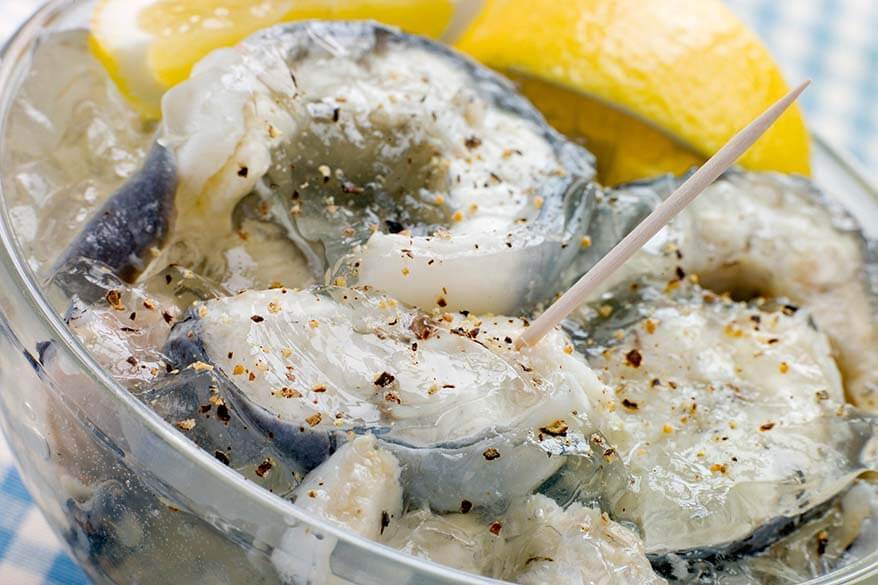
19. Scouse
You will often hear the residents of Liverpool in England referred to as ‘Scousers’. That nickname comes from the city’s traditional dish – scouse. It’s a sort of meat and vegetable stew.
There is some dispute about the correct recipe, but scouse is usually made with stewed meat, carrots, and potatoes. It’s served with beetroot and pickled red cabbage.
Scouce was originally a peasant food and would have been made with cheap cuts of mutton. And whilst these would have been quite bony and fatty, they gave the stew the best flavor and are still popular choices today. It is also fairly common to enjoy scouse ‘blind’, which means meat-free.
Origin: Being a port city, Liverpool has historically seen its fair share of sailors. It was the Northern European dish ‘Lobskause’ or ‘Lobscouse’ introduced by Norwegian sailors that was gradually adapted to become the ‘scouse’ that Liverpudlians enjoy today.
Where to try it: Scouse is almost unheard of outside of Liverpool, but you will find it on menus everywhere in the city. One of the best places to enjoy it is in Liverpool’s most famous pub – the Baltic Fleet – where you can wash it down with a glass of traditional ale.
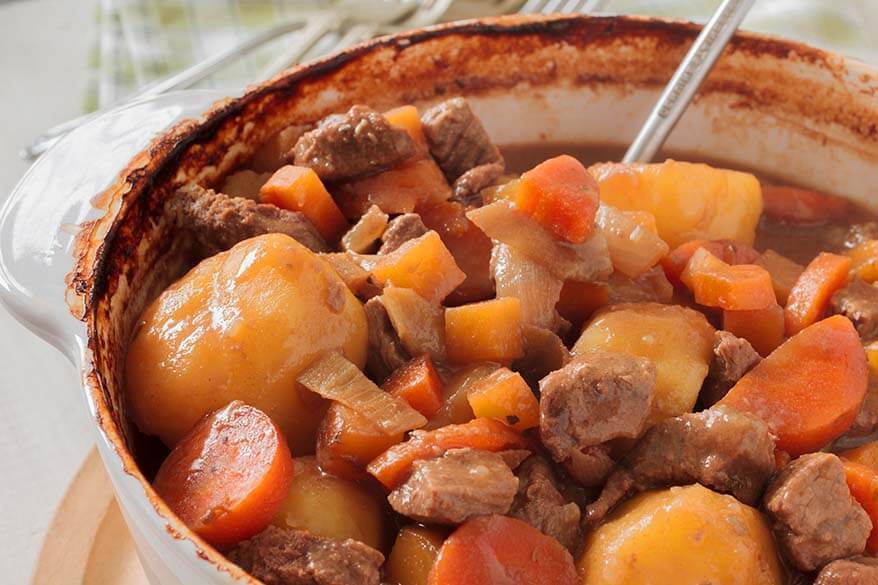
20. Laverbread
British food is renowned for its strange names – but surely laverbread is simply some type of regional bread? Wrong! Laverbread is actually made from seaweed! If you are looking for a really unique local dish to try in the UK, then this is as special as it gets!
To make laverbread, seaweed (laver) gathered from the Welsh coast is boiled, then pureed or minced before being fried. Sometimes oatmeal is added prior to frying.
It was traditionally served as part of a Welsh breakfast along with mushrooms, bacon, and sausages. Often served on buttered toast or even with shellfish, it has a rather unusual, salty flavor and a mushy texture.
It is definitely one of those quirky foods that you will want to tell your friends you were brave enough to try during your visit to the UK!
Origin: Laverbread is a Welsh dish with ancient origins. Some people suggest that the Vikings introduced it as survival food, whereas others say that the original coastal dwellers of Wales were the first to try it.
Where to try it: You can find laverbread on the breakfast menus of most upmarket Welsh restaurants. You can also buy some packaged laverbread at the local supermarkets (perhaps something to take home with you?).

21. Marmite
The manufacturers of Marmite once ran an ad campaign that stated ‘You Either Love It or Hate It’ – a clear indication that this much-loved British food isn’t necessarily for everyone!
Marmite is a very strongly flavored spread made from concentrated brewer’s yeast. And though it was first made in the UK, it was actually invented by a German scientist. The Marmite Food Company was subsequently founded in 1902 in Burton-upon-Trent in England, an area with many breweries and plenty of the raw ingredients needed to make it.
Brits love Marmite so much that it was included in the rations of WW1 soldiers. It was even sent out to boost the morale of soldiers in Kosovo in 1999.
Where to try it: Marmite has an intensely salty taste and is best enjoyed at breakfast time, spread very thinly on a slice of buttered toast. Most British cafes and restaurants will have Marmite available as a breakfast spread, so it’s the perfect time to try it and see if you become a lover or a hater! And if you love it, you’ll be glad to know that it’s available on Amazon.
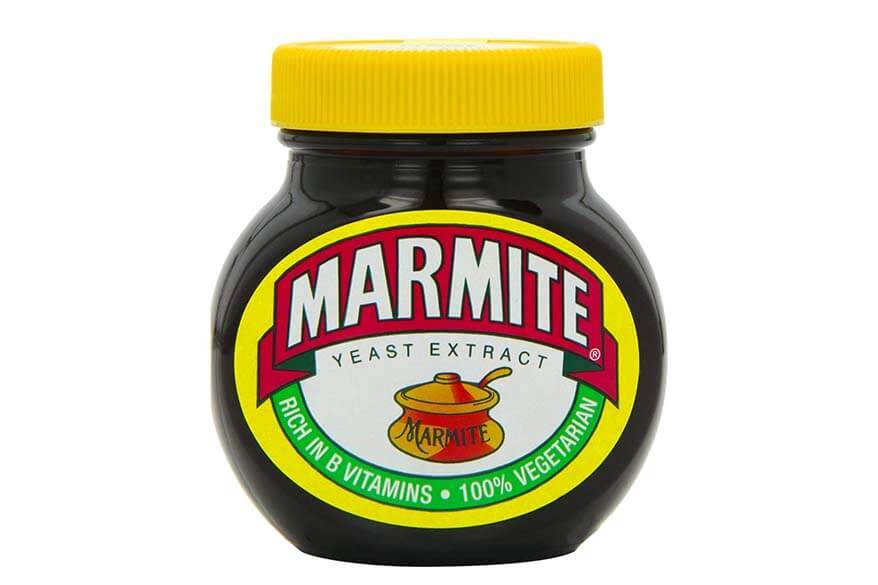
22. Scones
Brits are famous for their love of ‘afternoon tea’, a light meal served at around 4 pm. And one of the main components of a good afternoon tea is the scone! Scones are a type of bread, slightly sweet, small, and shaped something like a muffin.
And although traditional scones are slightly sweet, you’ll sometimes find savory versions too. Try cheese scones – they’re amazing!
Scones are available right across the UK, although quite how you pronounce their name isn’t clear. For most Brits ‘scone’ will rhyme with ‘gone’, whilst for others – and for those who live outside the UK – ‘scone’ rhymes with ‘bone’. No one is sure which is the correct pronunciation and the origins of this baked treat are somewhat unclear too.
Origin: Most people agree that the scone started out as a type of quick bread in Scotland, possibly as far back as the start of the 16th century. But the scones became REALLY popular in the early 1800s when a member of the British nobility ordered some ‘sweetbreads’ along with her cup of tea one afternoon. Scones were served and she loved them so much that she ordered them every afternoon from that day forwards. Thus, the afternoon tea was born!
Where to try it: You can find scones all over the UK, served with an afternoon tea. But for the very best scones, head down south to either Devon or Cornwall. Here they form part of a traditional ‘cream tea’, where they are served with a pot of tea, strawberry jam, and locally made clotted cream. A divine combination that simply has to be tried!
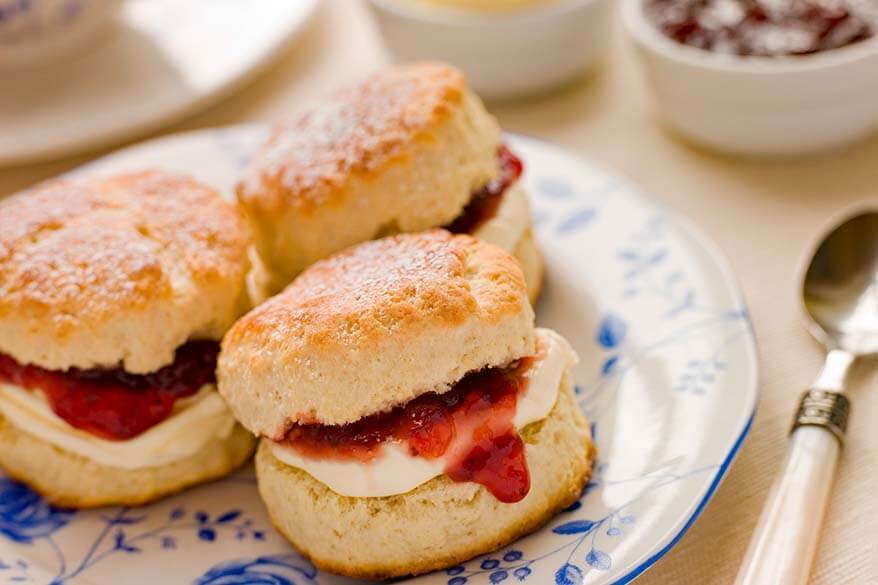
23. Spotted Dick
Spotted Dick is a traditional dessert enjoyed in all four nations of the UK. It is a steamed sponge pudding usually made with suet, filled with dried fruit (typically currants and raisins), and served hot with custard.
You may be wondering how this dish got its unusual name, but the answer is actually quite simple. In the late part of the 19th century, puddings were often referred to as ‘dicks’ or ‘dogs’. And – as this particular pudding is speckled with raisins – it became known as a Spotted Dick. It is called a Spotted Dog in Scotland.
A similar dessert is the lesser-known Jam Roly Poly which is also a steamed suet sponge but filled with jam rather than dried fruit.
Where to try it: Spotted Dick is something that people bake at home. It fell out of favor for a while in the UK, although – until recent years – it continued to be a staple part of the school lunch menu for British children. However, like many traditional foods in the United Kingdom, Spotted Dick has had something of a revival. It now appears on the menu of traditional British restaurants and many pubs.
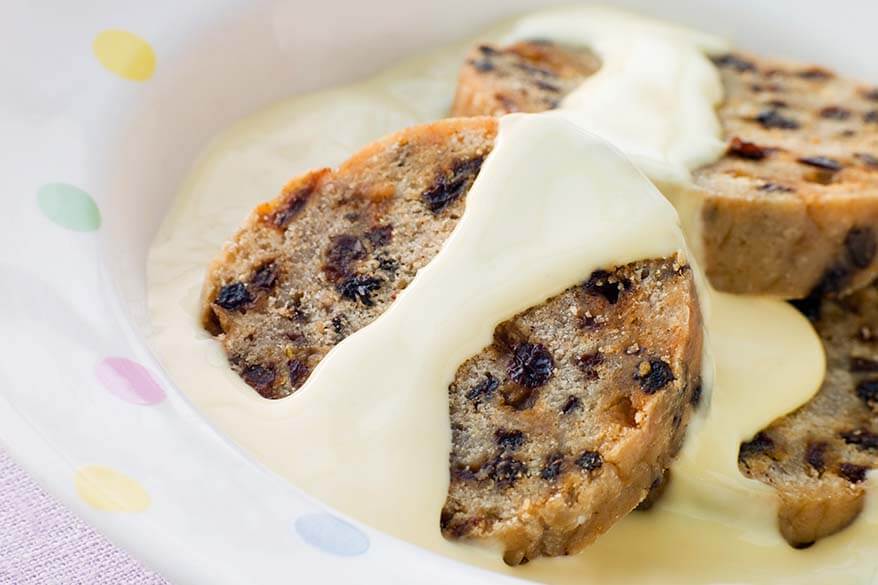
24. Jam Roly-Poly
Jam roly-poly is a popular dessert and a modern British classic! It was traditionally served after school lunch throughout the later part of the 20th century.
Its ingredients are simple: a dough made from suet is spread liberally with jam, rolled up like a Swiss roll, then steamed or baked. Jam roly-poly is served topped with plenty of steaming custard, which – along with the jam – provides the sweetness. The dough contains no sugar at all.
Even its biggest fans will describe it as ‘stodgy’, but that’s exactly the point of this dessert. It is hearty, comforting, and designed to warm you up on a chilly day!
Origin: The recipe for jam roly-poly was created by English food writer Eliza Acton, who published one of England’s first cookbooks – Modern Cookery for Private Families. The dessert proved to be so popular that it has even taken a place in British literature. The famous books of Beatrix Potter include the title ‘The Tale of Samuel Whiskers or The Roly-Poly Pudding’, where Tom Kitten almost ends up rolled into a pudding himself!
Where to try it: You can find jam roly-poly served at many traditional British pubs across the UK. You’ll even find it at the restaurants of English celebrity chef Jamie Oliver.
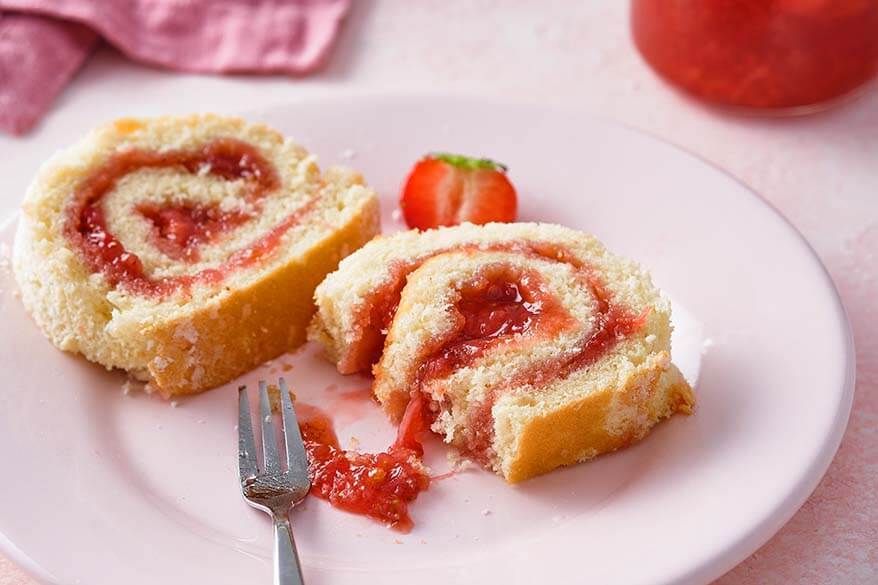
25. Trifle
The classic British trifle is a wonderful dessert that brings together a whole range of sweet ingredients to create a glorious and indulgent dish!
Typically served after Christmas dinner, a trifle starts with a layer of sponge fingers at the bottom that has been soaked in sherry or some other type of alcohol. This is enclosed in a layer of jelly containing fresh fruit. It is then topped with a thick layer of homemade custard and a further layer of fresh whipped cream. The entire dish is usually then decorated with brightly colored sprinkles!
It is actually lighter than it sounds, making a refreshing end to a big meal. Scotland puts its own twist on this traditionally English recipe with its ‘tipsy laird’, where the sponge fingers are soaked in whisky or whisky liqueur instead of sherry.
All parts of the UK also serve a non-alcoholic version, usually known as ‘fruit trifle’. In this version, the sponge is usually soaked in fruit juice instead.
Where to try it: Brits tend to prepare trifle at home and it is hard to find in restaurants. Although restaurants with a traditional British menu are more likely to serve it. You can also buy trifle (usually the non-alcoholic version) in most supermarkets.

26. Eccles Cakes
Any time you pass a British bakery, be sure to pop in and treat yourself to an Eccles Cake! These buttery baked treats look like a small round pie. They contain currants, mixed with candied citrus peel and spices like cinnamon, nutmeg, allspice, and cloves. This sweet filling is then encased in a sweet, flaky pastry topped with demerara sugar.
Eccles Cakes are named after the town of Eccles in Lancashire where they were first sold commercially in 1793 by shopkeeper James Birch. Their history, though, dates back even further and is quite fascinating. The country at that time was ruled by very strict Puritans. They decreed that Eccles Cakes were inappropriately indulgent and sinfully tempting, then went on to ban them!
Fortunately, the ban was lifted at some point and these little pastries have gone on to gain a worldwide following, with cakes from the ‘Real Lancashire Eccles Cakes’ factory being shipped across the globe. Eccles Cakes are best enjoyed with that most ubiquitous of British beverages – a nice hot cup of tea.
Where to try it: You’ll find Eccles Cakes in bakeries and coffee shops all over the UK.

27. Christmas Pudding
Christmas Pudding is served after almost every traditional British Christmas dinner. It’s a rich and luxurious mixture of dried fruit, peel, breadcrumbs, and alcohol with dark sugars and sweet spices.
The recipe hasn’t always been quite so tempting, however. Christmas pudding has its origins in the 14th-century dish ‘frumenty’, which – along with the fruit and alcohol – also contained beef and mutton. By the end of the 16th century, the recipe changed to the dish that Brits enjoy today.
Christmas Pudding gradually became a typical Christmas dessert, although the Puritans banned it in 1650 for being sinful. Fortunately, King George I brought it back as part of the Christmas meal in 1714. It has been around ever since.
Where to try it: You will only be able to try Christmas Pudding if you’re actually visiting the UK at Christmas. It’s virtually unheard of to eat it at any other time of year. But throughout December, you’ll find it on the menus of lots of pubs and restaurants, where it is served with custard, cream, or brandy butter. Some restaurants will serve it to you at the table the traditional way, which involves pouring alcohol over the top and setting it alight, making this unique dish just a little more memorable!
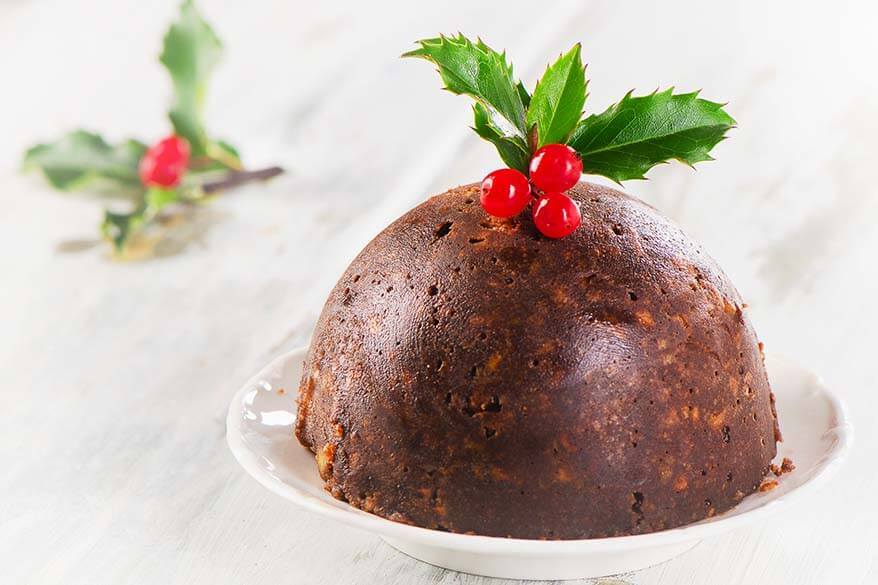
28. Bread and Butter Pudding
Another warm and comforting dessert enjoyed by chilly Brits in the winter months is Bread and Butter Pudding. It may not sound appealing but it tastes so much better than you might imagine. It certainly tastes a lot better than ‘whitepot’, the medieval dish that inspired it and was made with bone marrow!
Today’s Bread and Butter Pudding is based on a recipe used by frugal British housewives to avoid wasting their stale loaves. Slices of buttered bread are arranged at the bottom of a dish, sprinkled with dried fruit such as currants or raisins, then completely covered in a sweet egg custard. A little nutmeg is usually added too. Then the whole thing is baked until the custard is set and the top is golden and crispy.
Where to try it: You can find it on the menus of many traditional pubs and restaurants all over the UK. Although you might find that many of the better restaurants try to ‘improve’ the recipe by switching the bread for something a little more exotic, such as brioche, panettone, or croissants. Most Brits will agree, though, that the rustic Bread and Butter Pudding made with plain white bread and served in local pubs is the best type to try.

29. English Tea with Milk
The British are famous across the world for their love of a ‘cup of tea’. Unlike in many other countries, however, British tea is served with milk.
Origin: This tradition dates back to the 18th century when tea was first introduced to the nation. Loose leaves were brewed in teapots and not in the cup as they are today. Instead of the fine bone china used to serve tea now, most people only had access to cups of far lesser quality. The cups were prone to cracking when the boiling tea was poured into them. To get around this problem, the Brits would pour cold milk into the cup first to bring down the temperature and prevent it from shattering.
The people obviously preferred the new taste and it stuck.
Whilst some people think that Earl Grey is one of Britain’s most popular teas, it is actually quite unusual to find it anywhere outside of the best restaurants. In most cases, if you ask for a cup of tea in the UK, you’ll be served either Kenyan or Assam black tea – also known as ‘breakfast tea’ – along with milk and the option to add plenty of sugar. And most Brits will tell you that’s the only way to enjoy it!
Where to try it: Tea with milk is now served in all four nations of the UK and is almost a standard part of the Full English Breakfast! You can find it everywhere – from hotel breakfast to finest restaurants.
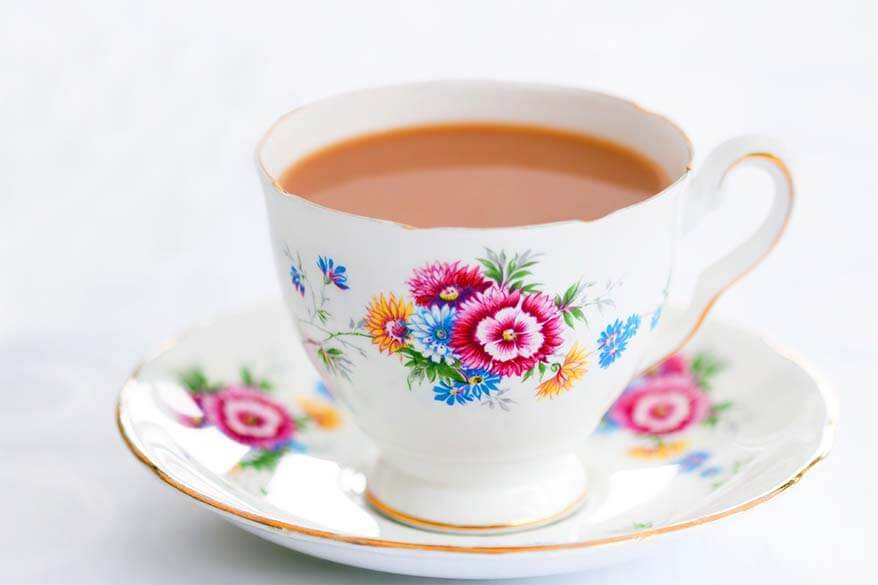
So, this is our list of the very best British dishes and desserts. I hope that this will inspire you to try some traditional food when visiting the UK, beyond the most popular options.
As you can see, some truly delicious (and sometimes also strange) dishes hide behind some weird names. So next time you see ‘Bangers and Mash’ or ‘Toad in the Hole’, or ‘Spotted Dick’ on the menu, definitely give it a try.
More tips for your trip to the UK:
- Where to go: Best Cities To Visit in the United Kingdom
- Cornwall: Best Things to Do in Cornwall & Best Towns to Stay in Cornwall
- Yorkshire: Yorkshire Day Trips
- Manchester: Best Things to Do in Manchester & 1 Day Manchester Itinerary
- Liverpool: Best Things to Do in Liverpool & Day Trip to Liverpool from London
- Blackpool: Best Things to Do in Blackpool & Blackpool Travel Tips & Best Places to Visit near Blackpool
- Scotland: Isle of Skye Itinerary & Scotland Whisky Tour
- Edinburgh: Best Things to Do in Edinburgh & One Day in Edinburgh & Tips for Visiting Edinburgh
- Glasgow: One Day in Glasgow
London travel inspiration:
- Good to know: Tips for Visiting London
- What to see: Top London Sights & Attractions
- Where to stay: Best Areas to Stay in London
- Off the beaten path: Hidden Gems of London
- Nearby: Best Day Trips from London
- Itineraries: 1 Day in London & 2 Days in London
- City views: Best Views in London
- Greenwich: Things to Do in Greenwich & Painted Hall & Queen’s House and Tulip Stairs
- Camden: Camden Town & Camden Lock Market
- Canary Wharf: Best Things to Do at Canary Wharf
- For families: London with Kids & London with Teens
READ ALSO: Traditional Italian Food & Traditional French Food
If you found this post helpful, don’t forget to bookmark it and share it with your friends. Are you on Pinterest? Pin these images!
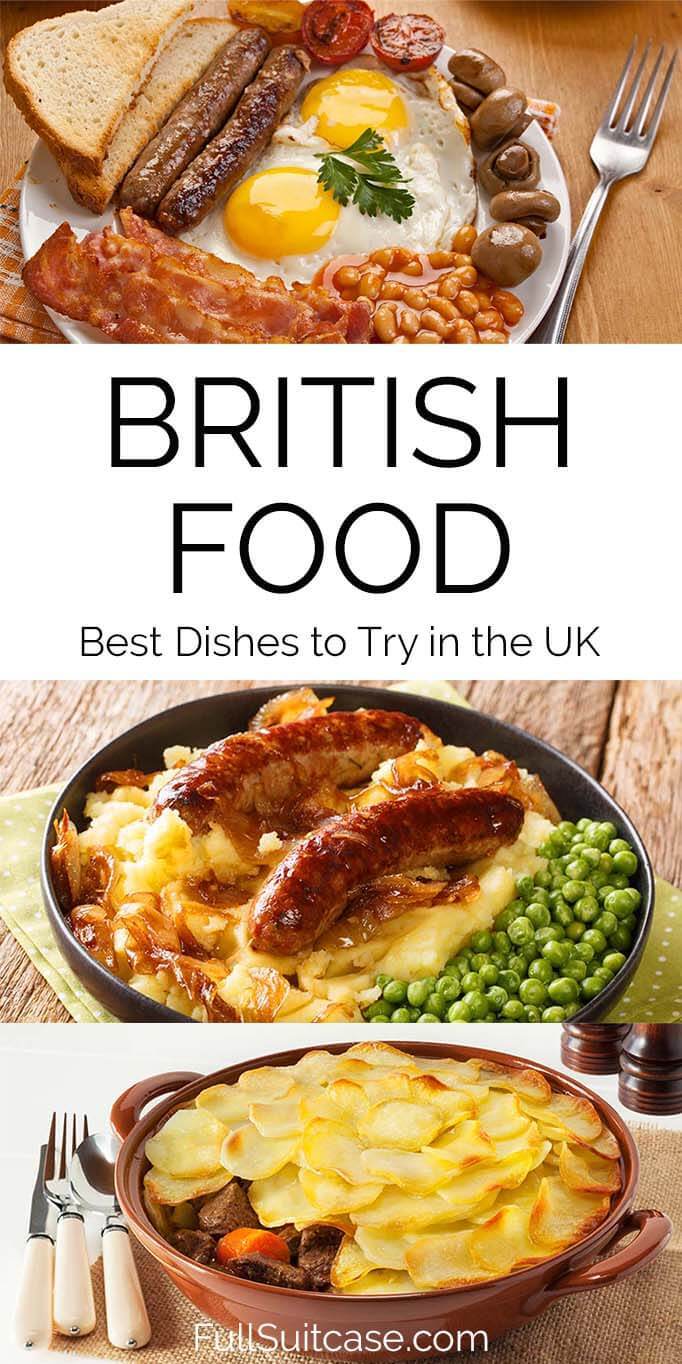
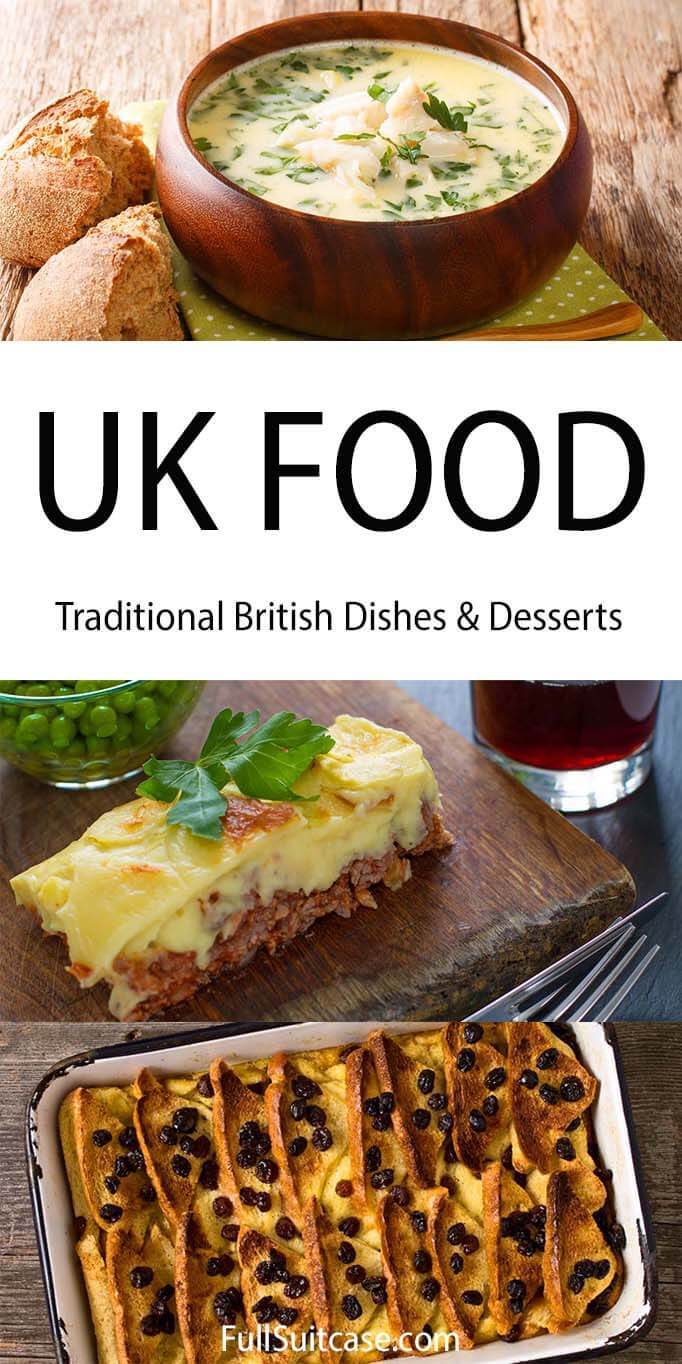
Image credits: Depositphotos.com and iStockphoto.com
This site contains affiliate links, which means that we may earn a small commission, at no cost to you, for qualifying purchases. More info: Disclosure.

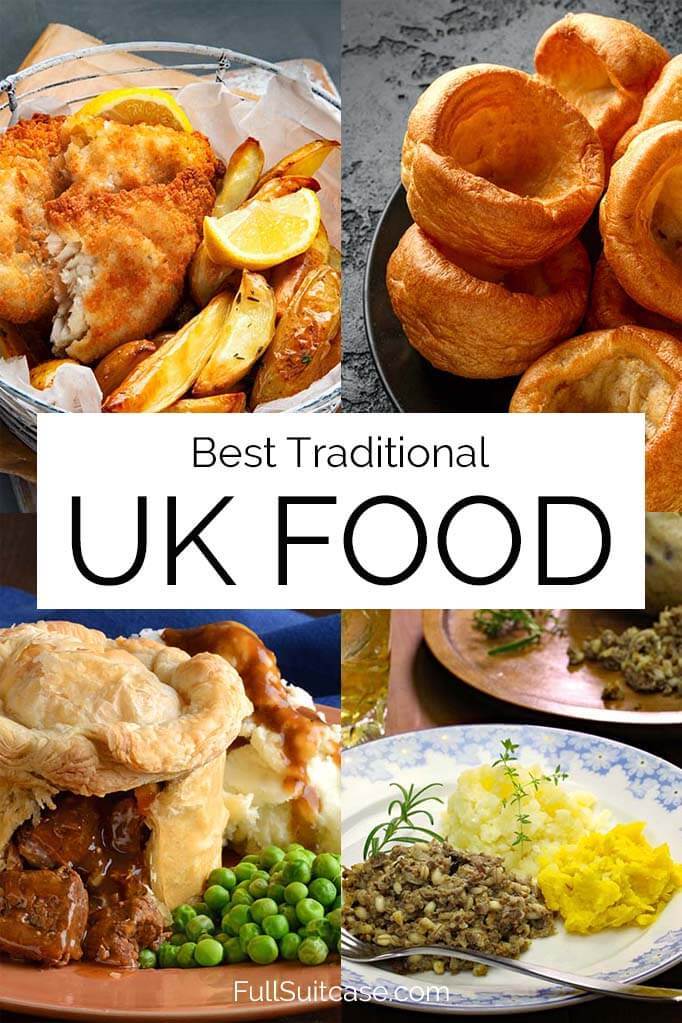







These dishes really hit me with a wave of homesickness. After living in the U.S. for the past two years, I’ve been missing home more than ever.
You are not right on your write up on Yorkshire Puddings. They can indeed be sweet by adding sugar to the batter and cooking it with fruit dropped on the batter. Serve with cream. In the Midlands we used to have this regularly and it was called drop pudding.
Wow, so many interesting dishes. I had no idea! We will be visiting London soon and I can’t wait to try some of these.
Enjoy London, Karen, and if you are looking for some tips on what to see and do, you can find an overview of all our London articles here.
You forgot APPLE PIE! It’s from Britain originally!
Owned a small hotel in Paignton and served English breakfasts . Never tomatoes and never lettuce and in the photo the bacon is American . Guests loved the British bacon , tea and toast .
@Charles, Indeed, in regards to tomatoes it’s either tinned or a fried FULL size tomato cut in half.
NEVER lettuce.
BRITISH bacon..
And are they hot dog sausages on the plate? NEVER!
If you are in Wales you need to try Welsh cakes . They are a cross between a scone and a cookie made traditionally with currents. They are cooked on a griddle and sold all over Wales. If you are in the capital go to a little shop opposite Cardiff Castle to see them being made. And eat them ‘hot off the griddle’
Sounds delicious. Thanks for the recommendation, Sue.
That picture is looks a lot more like a Jam swiss roll, rather than a jam roly-poly. The crucial difference is that roly-poly is a rolled up suet pudding, not a rolled up cake. The result is much richer and holds up much better when reheated.
@Jacob, During my military service compo rations often contained roll poly and it was always suet . Never cake and l ate it straight out of the can with tinned milk .
Don’t like stake and kidney
Ha ha, not my favorite either. 🙂
@Myles, then try STEAK pie without the kidney, many people aren’t keen on kidney.
What about food in Conwy
The best way to try some super local specialities is simply ask the locals when you get there.
Ireland is not Britain. It is its own country.
The last time I checked, Northern Ireland was part of the UK. And Irish stew is also eaten in Northern Ireland.
Let’s not get too political. 😉
@mmm, Northern Ireland is part of the United Kingdom
@mmm, Ireland is a part of the British Isles. So British.
Your pic of a cornisb pasty is actually a Devonshire pasty. Cornish Pasties are made in a flat, distinctive ‘D’ shape, with a flat underside and the crust along the curve.
Source: am Cornish, live in Cornwall.
Good observation, Matt, but since this is not a food blog and we are not cooking any of these dishes, we have to rely on the pictures we can legally acquire, sometimes meaning that they can be somewhat different from what you imagine when you think of a specific dish. Like anywhere in the world, every cook makes food a bit differently and so ingredients, shapes, and tastes can differ too. Even fish and chips can look totally different depending on where you eat them. 😉
Steak and Kidney pie and pudding are completely different entities. Pies are oven cooked using shortcrust pastry, puddings are steamed using suet pastry. The photo of black pudding is most likely Morchilla, Spanish black pudding, British puddings are much larger and served in slices. Scouse is a version of Irish stew, Liverpool being so close to Dublin that thousands of Irish traveled over to work on the docks. Jellied eels surprisingly are hated by most Brits, I find them disgusting, yet my dear old dad loved a tub of them!
Oh and one other thing, anybody who puts Guinness in Irish stew (I’ve never seen it) should be serving time. 😉
Cranberry sauce is served with turkey, not chicken. Apple sauce is served with pork, rarely mustard. Traditionally, stuffing is served only with poultry and Yorkshire pudding only with beef, but that’s not a rule we stick to much these days.
Would love to visit England
It’s a good time to do this now since the British pound is so weak. 😉
I love this list, Jurga. My roots are in Scotland and even here in the US, we eat most of these dishes on many occasions. The only thing that I’d add is clootie dumpling which is a traditional Scottish pudding. It’s sweet, not like the black pudding ;).
One more addition, wow! You seem to have so many special and truly unique dishes in the UK! Thanks for sharing.